What to Do in Brazil on a Family Vacation
ABOUT
At Our Whole Village, we plan meaningful vacations for families who want to create lifelong memories and show their kids the world in a more conscious and intentional manner.
WORK WITH US
We help families take meaningful vacations so that they can escape everyday life, show their kids the world and make lifelong memories - with care, confidence and peace of mind.
THE BEST FAMILY VACATIONS BY AGE
Your (free) guide to the top travel destinations for families with babies, teens and everyone in between.
DOWNLOAD NOW
ABOUT US
October 20, 2019
What is there to see in Brazil? From spectacular beaches to tropical rainforests and archipelagos pulsing with life, Brazil’s unique landscapes are matched by its warm hospitality, delectable cuisine, and vibrant music. What’s more, Brazilians adore children. As a result, kid-friendly accommodations abound.
Here’s our list of what to do in Brazil on a family vacation.
Rio de Janeiro
Rio de Janeiro combines the charm of a multicultural village with the energy of a metropolis. It contains endless kid-friendly spots, making it a vibrant family travel destination. Spend a sun-kissed day splashing in the surf and building sandcastles with your kids at one of Rio’s stunning beaches like Leblon, Ipanema, or Copacabana.
Take a swan-shaped paddle boat around the city’s most scenic lake, Lagoa Rodrigo de Freitas. Or, stroll along Copacabana’s Avenida Atlantica. This 2.5-mile expanse of roadway closes one way every Sunday for pedestrians, bikers, and skaters. There, you’ll find plenty of bike, push, and peddle car rentals. You’ll also discover plenty of food vendors and street performers. Come prepared to savor Brazilian culture at your own pace.
Of course, no family trip to Brazil would be complete without visiting two of Rio’s most iconic landmarks, Sugarloaf Mountain and the iconic Christ the Redeemer statue. Sugarloaf Mountain offers stunning views of the city and is easily accessible by cable car. To get to the Christ the Redeemer Statue, take a train cog ride up the Corcovado mountainside. You’ll pass through Tijuca National Park, a 15 square mile (93 square-km) remnant of the Atlantic rainforest that once enveloped the region. Along the way, enjoy stunning vistas of verdant jungle terrain, creeks, and waterfalls.
For families who’d like to spend additional time exploring the park’s historical spots and natural landscapes, opt for a jeep tour of the park. Tijuca also contains a system of well-marked hiking trails. More ambitious visitors can hike to the summit of Pico de Tijuca (3,320 feet/1,012 m). The Alto do Boa Vista area represents the heart of the park. There, you can see a handful of scenic waterfalls, numerous caves, and a lovely 19th-century chapel. At Bom Retiro, enjoy a picturesque picnic. Or, dine at one of two nearby restaurants, Restaurante Os Esquilos or Restaurante Barão a Floresta.
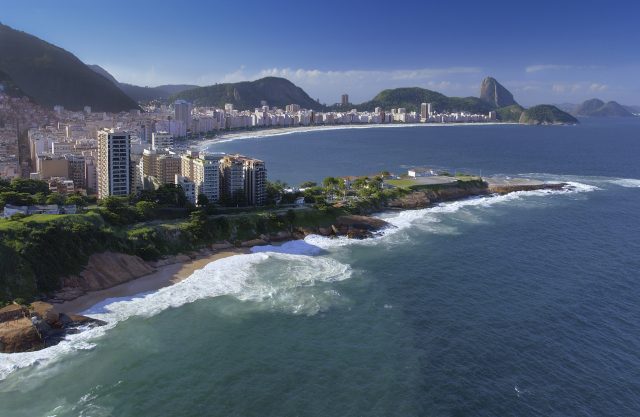
© Steve Allen | Dreamstime.com
Manaus: Gateway to Amazonia
From Manaus, take a boat tour to the “Meeting of the Waters.” A confluence between the dark waters of the Rio Negro and pale waters of the Rio Solimões, it stretches for nearly four miles. Because of differences in water temperature, speed, and density, the two rivers meet yet don’t combine creating a spectacular visual effect.
Back in Manaus, dine at one of the city’s floating restaurants. You’ll enjoy gorgeous river views, local cuisine, and glimpses of jungle wildlife and plants (including large, kid-sized lily pads). Or, rent three-wheeled cycles and explore the city’s expansive main square.
No visit to Manaus would be complete without checking out the Teatro Amazonas (Amazon Theater), a grand opera house located in the city’s main square. It remains a fitting testament to the city’s wealth at the height of the rubber boom. Stepping inside the theater transports you back to Gilded Age opulence. The 700-seat theater contains one hundred and ninety-eight chandeliers imported from Italy, 32 crafted from Venetian Murano glass.
The theater also offers a unique acoustical experience. It contains 22 vibrating hollow columns comprised of Scottish cast iron that create this effect. The theater was modeled after the interior of the Palais Garnier in Paris, and with good reason. Late 19th-century Manaus was knowns as the “Paris of the Tropics.” And don’t forget to look up. There’s even a reference to the Eiffel Tower in the theater’s ceiling painting!
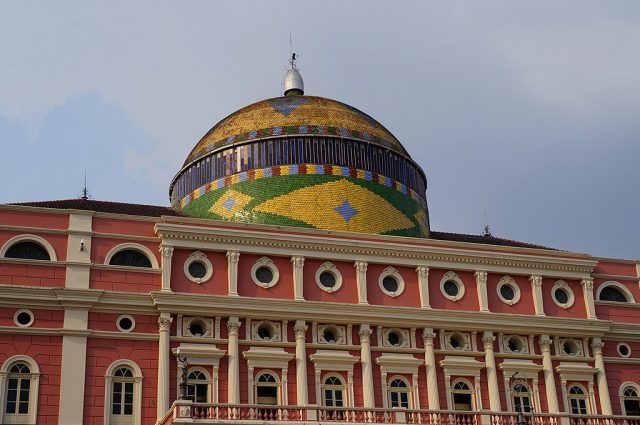
© Leandro Neumann Ciuffo | Wikimedia Commons
The Amazon Rainforest
Sail through the archipelago of Anavilhanas, located 43 miles upstream from Manaus. One of the most massive island clusters in the world, the archipelago comprises of more than 350 elongated islands. Each one is teeming with wildlife, including aquatic species like cayman, dolphins, manatees, and bounties of fish.
Located on Brazil’s Negro river, the archipelago receives 83 inches of rainfall annually and contains rivers, lakes, flooded forests in the rainy season, and beaches in the dry season. Originally designated as an ecological station in 1982, the area became a national park in 2008.
When it comes to Brazil for kids, the archipelago provides a living lesson in Brazilian ecology and conservation. Among the protected species you may see in the park are giant otters, giant anteaters, macaws, and myriad other bird species.
After time spent cruising through Anavilhanas, head into Jaú National Park. In Jaú, you’ll see the rainforest’s many creatures — from spider monkeys and toucans to freshwater dolphins and black caiman — without worrying about mosquitos, cell phones, or other intrusions from the outside world.
Encompassing nearly 9,000 square miles (23,000 square km), Jaú is home to impressive waterfalls. For a change of pace, visit one of the area’s riverside communities where visitors get welcomed with open arms.
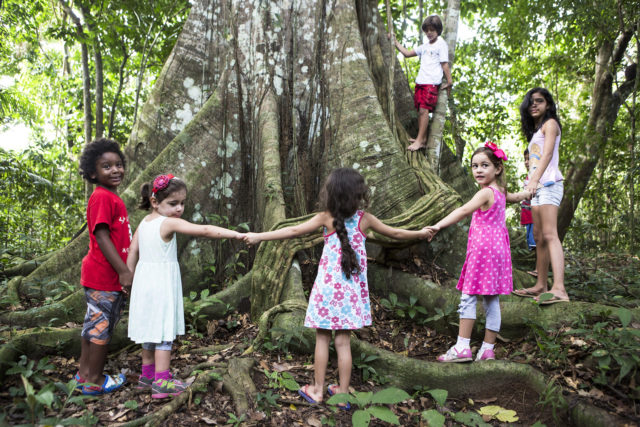
© Our Whole Village
Lençóis Maranhenses National Park
At first glance, the expansive white dunes of Lençóis Maranhenses look like the epitome of a desert landscape. Stretching into the horizon, it’s easy to see how these dunes got their name. In Portuguese, Lençóis Maranhenses translates as the “bedsheets of Maranhão.” (Maranhão refers to the northeastern coastal state where the park is located.)
That said, Lençóis Maranhenses is no desert. It receives 47 inches of precipitation each year, making it too rainy for official desert status. (That honor goes to places that receive less than ten inches annually). During the rainy season, from January to June, the park sees the bulk of its precipitation in torrential rain.
As rainwater pools between the dunes, it creates an otherworldly landscape filled with thousands of crystal clear lagoons. Reaching their peak in July, some of the turquoise lagoons measure more than 300 feet long and ten feet deep!
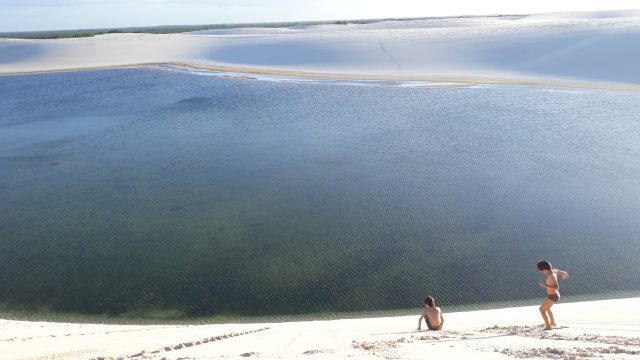
© Daniela Lacerda
Chapada Diamantina
A diverse and dramatic destination, Chapada Diamantina National Park’s landscapes appear surreal. It is a land of quartzite cave systems, subterranean rivers, and pristine lakes. It is also a land punctuated by red-rock mesas and dramatic canyons and caverns whose cake-like sedimentary layers have been carved for millennia by wind and water.
Established in 1985, this 375,000-acre reserve sits in the northeastern state of Bahia, the very heart of Brazil’s former diamond mining industry. The historic affluence of the area remains impressed on the landscape in the lovely colonial architecture of communities bordering the park.
But the real wealth of the area rests in the park’s many natural wonders. Whether heading out on one of the park’s hiking trails (some of which follow colonial mining routes) or discovering its sublime waterfalls, this ecotourism gem is a must-see.
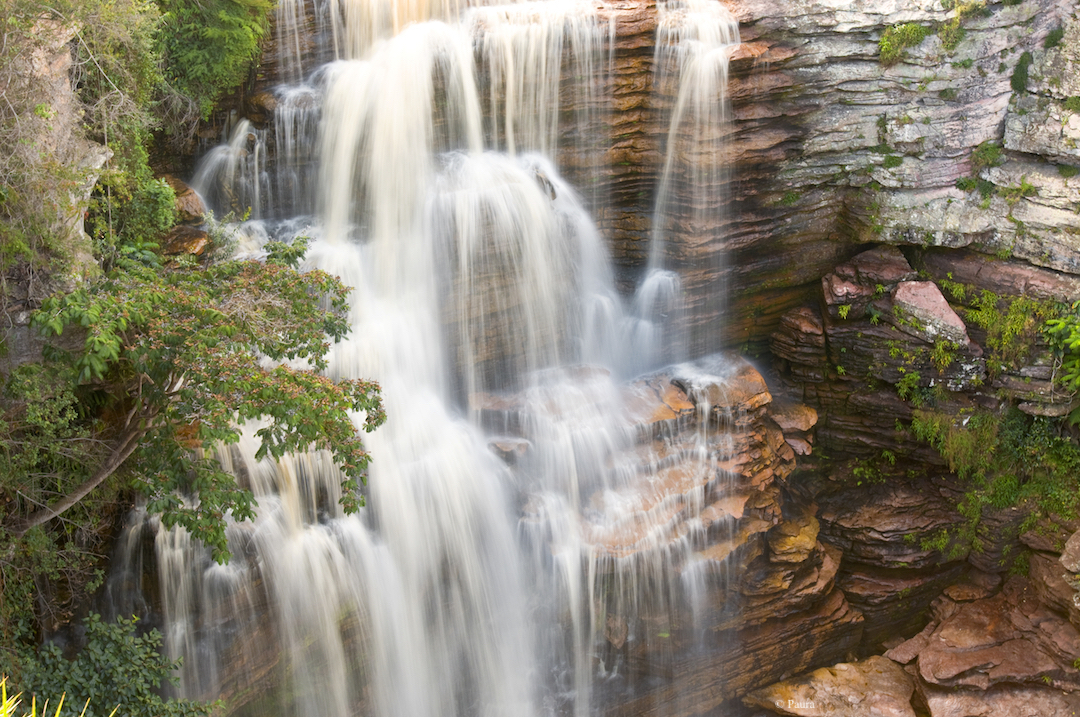
© Paura | Dreamstime.com
Salvador
After taking in the gorgeous canyons, waterfalls, and cave systems of Chapada Diamantina, head to Salvador, the capital of the Brazilian state of Bahia. Salvador has an impressive history as one of the oldest colonial cities in the Americas. But it’s also a modern urban center offering delicious food, exotic music, and dynamic street performances.
Learn more about the rich cultural traditions of West and Central Africa in Brazil by attending a Capoeira and drums class. Capoeira dates back more than 500 years to the start of the slave trade in Brazil and remains a testament to self-discipline, resilience, and courage in the face of oppression.
For a change of pace, head to the archipelago of Morro de São Paulo via hydrofoil. This island consists of many white sand beaches and turquoise waters. A car-free zone, the island moves at a slower pace, one that’s kid-friendly and conducive to optimal vacation relaxation.
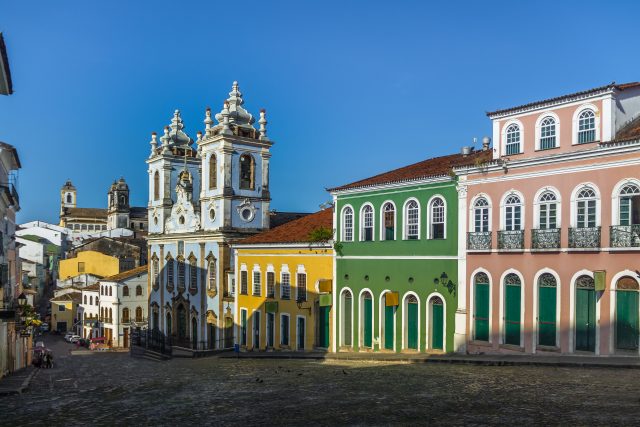
Pelourinho – Salvador, Bahia, Brazil
Iguazu Falls
Imagine 275 individual drops combining to form an epic waterfall of thunderous proportions. The exquisite Iguazu Falls (alternatively Iguassu or Iguaçu Falls) have been wowing visitors and indigenous inhabitants for centuries. (The name comes from the Tupi-Guarani language and translates as “big water.”)
The waters of the Iguazu River feed the falls, which divide into the upper and lower portions. The river forms the boundary between Argentina and Brazil and provides spectacular views on both sides of the border. Walkways built around the falls allow visitors the chance to get close to the raw beauty and power of the falls. Just prepare to get wet, something your kids will love!
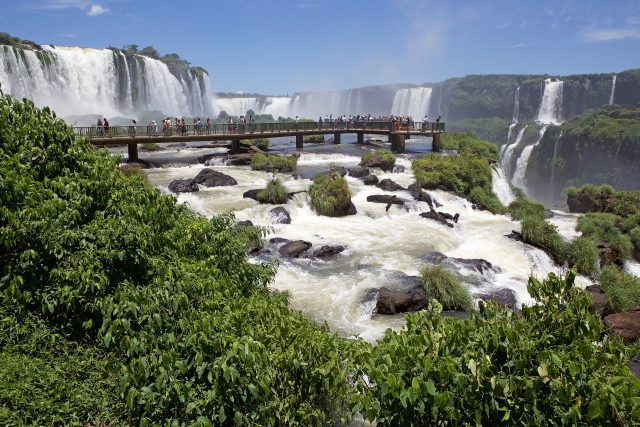
© Antonella865 | Dreamstime.com
Bonito and the Rio da Prata
The southwestern town of Bonito, located in the state of Mato Grasso do Sul, is known for its gorgeous caves and river snorkeling adventures. Take a short drive through the lush forests surrounding the Rio da Prata (Prata River), to the mouth of the river where you can leisurely float in its crystal clear waters while taking in vibrant schools of fish.
Because of the current, you’ll have to do very little swimming as you float along, observing a spectacular parade of fish. Although the water can feel cold, an excellent snorkeling tour company will provide wetsuits as needed, which also helps with buoyancy. It’s a spectacular adventure that you and your kids won’t soon forget. Just remember to bring a waterproof camera!
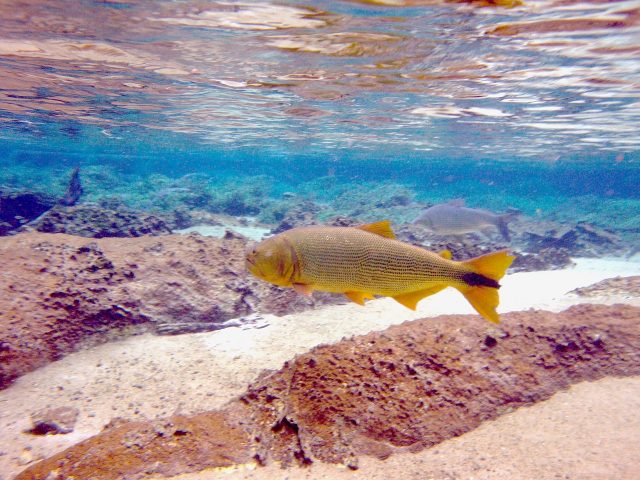
© Jonas Techy Potrich | Wikimedia Commons
Pantanal
Nestled on the edge of the Amazon sits Brazil’s Pantanal region, the largest wetland ecosystem in the world. Measuring a whopping 81,000 square miles (210,000 square kilometers), it’s nearly the size of Kansas.
The Pantanal harbors the highest concentration of wildlife in South America including 325 species of fish, 656 species of birds, 53 species of amphibians, 98 species of reptiles, and 159 species of mammals.
Since the foliage proves less dense here, your odds of spotting exotic species skyrockets. Keep your eyes peeled and your cameras ready, since Pantanal is the best place in Brazil to spot the elusive jaguar. From cayman to capybaras, toucans to howler monkeys, you and your kids will feel exhilarated by the Brazilian parade of wildlife.
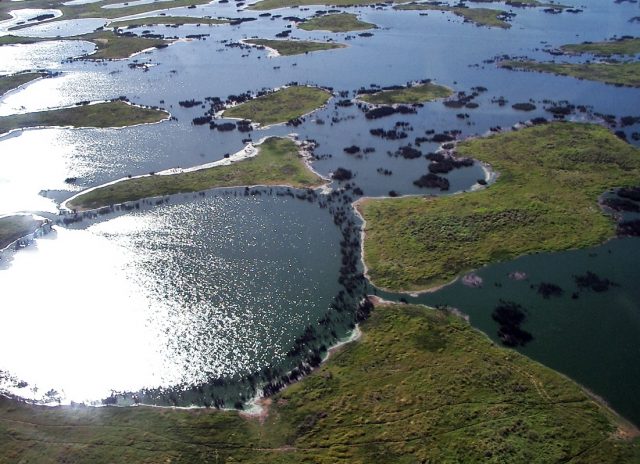
© Alicia Yo | Wikimedia Commons
What to Do in Brazil on a Family Vacation
From the sunny beaches of Copacabana to the depths of the Amazon rainforest, when it comes to what to do in Brazil, you have endless options. Check out our ultimate family travel guide to Brazil with kids for more on what to know before going to Brazil.
Also, check out our Brazilian Amazon River Cruise, an immersive exploration of one of the most pristine rainforest parks in the world. Or, learn more about our 8-day Chapada Diamantina/Salvador Adventure, an unforgettable journey into the heart of one of the world’s magnificent natural landscapes.
At Our Whole Village, we create transformational trips for curious families who want to create lasting memories while making a difference. We’re here to help you and your family experience the world, its people, and its cultures. Contact us to learn more about the unforgettable journeys that we handcraft for adventure-seeking families just like yours.
OUR SERVICES
HOME
COPYRIGHT © OUR WHOLE VILLAGE 2021
DESIGN BY GIRLBOSS DESIGNER | CUSTOMIZED BY ALEX COLLIER DESIGN
about
TRAVEL SERVICES
DESTINATIONS
BLOG
PLAN A TRIP
FREE TRAVEL GUIDE
TERMS AND CONDITIONS
hello@ourwholevillage.com
+1 305 432 2612